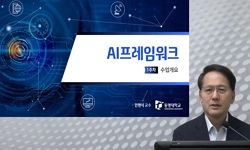본 연구는 딥러닝을 활용하여 건축물의 외관 이미지를 기준으로 객관적인 유형화를 할 수 있는 방법론을 개발하였다. 기존의 유형화는 분석자의 주관에 의존하고 분석 대상의 수에 한계가 ...
http://chineseinput.net/에서 pinyin(병음)방식으로 중국어를 변환할 수 있습니다.
변환된 중국어를 복사하여 사용하시면 됩니다.
- 中文 을 입력하시려면 zhongwen을 입력하시고 space를누르시면됩니다.
- 北京 을 입력하시려면 beijing을 입력하시고 space를 누르시면 됩니다.
딥러닝을 활용한 건축물 외관의 유형화 방법론 개발 : 국내 공공청사를 중심으로 = Deep Learning Based Typification Method for Building Exterior
한글로보기https://www.riss.kr/link?id=T16865201
- 저자
-
발행사항
서울 : 서울대학교 대학원, 2023
- 학위논문사항
-
발행연도
2023
-
작성언어
한국어
-
주제어
CNN ; k-means clustering ; 유형화
-
DDC
690
-
발행국(도시)
서울
-
형태사항
v, 115 ; 26 cm
-
일반주기명
지도교수: 조항만
-
UCI식별코드
I804:11032-000000179058
- DOI식별코드
- 소장기관
-
0
상세조회 -
0
다운로드
부가정보
국문 초록 (Abstract)
본 연구는 딥러닝을 활용하여 건축물의 외관 이미지를 기준으로 객관적인 유형화를 할 수 있는 방법론을 개발하였다. 기존의 유형화는 분석자의 주관에 의존하고 분석 대상의 수에 한계가 있었다. 따라서 본 연구에서는 전국 279개의 공공청사를 중심으로 딥러닝을 활용한 객관적인 외관 유형화 방법론을 구축하였다. 이를 위하여 일차적으로, 국내 공공청사에 대한 전수조사를 하고 이미지 데이터셋을 구축하였다. 다음으로, 딥러닝 모델 중 CNN을 활용하여 청사 이미지 특징을 학습하는 모델을 수립하였다. CNN 모델에서 분류한 feature를 바탕으로 k-means clustering을 통해 최종적으로 12개의 클러스터로 유형화하였다. 유형화 결과 각 클러스터 간 유사도를 통해 클러스터별 외관 특징을 분석할 수 있었고, 높이, 입면 패턴, 재료, 입면 돌출 및 지붕 구조라는 분류체계를 수립할 수 있었다. 선행연구와의 비교 분석을 통해 본 연구의 방법론은 검증되었다. 이러한 외관 유형화에 영향을 미친 요인을 분석하기 위해 통계 및 기계학습 분석을 실시하였다. 이를 통해 층수, 준공년도, 연면적, 대지면적, 지역을 기준으로 각 유형의 특성을 도출하였다. 이러한 연구 결과는 공공청사 현황 분석의 기초 연구 및 다양한 건축물의 유형화 연구에 적용될 수 있을 것이다.
다국어 초록 (Multilingual Abstract)
This study developed a methodology that can objectively typify based on the exterior image of a building using deep learning. Existing typification depend on the analyst's subjectivity and have limitations in the number of analysis subjects. Therefore...
This study developed a methodology that can objectively typify based on the exterior image of a building using deep learning. Existing typification depend on the analyst's subjectivity and have limitations in the number of analysis subjects. Therefore, in this study, an objective exterior typification methodology was established using deep learning, focusing on 279 domestic public office buildings. To this end, first of all, a full investigation of public office buildings in Korea was conducted and an image dataset was constructed. Next, we established a model that learns the features of the building images by using CNN among deep learning models. Based on the features extracted by the CNN model, they were finally grouped into 12 clusters through k-means clustering. As a result of the clustering, it was possible to analyze the exterior characteristics of each cluster through the similarity between each cluster, and it was possible to establish a typification system of height, elevation pattern, material, elevation protrusion, and roof structure. The methodology of this study was verified through comparative analysis with previous studies. Statistical and machine learning analysis was conducted to analyze the factors that influenced the typification result. Through this, the characteristics of each type were derived based on the number of floors, completion year, total floor area, site area, and region. The results of this study can be applied to basic research on analyzing the current state of public office buildings and typification of various building types.
목차 (Table of Contents)
- 제 1 장 서론 1
- 1. 연구의 배경 1
- 2. 연구의 목적 3
- 3. 연구의 방법 4
- 제 1 장 서론 1
- 1. 연구의 배경 1
- 2. 연구의 목적 3
- 3. 연구의 방법 4
- 제 2 장 이론적 배경 5
- 1. 건축 유형화 5
- 2. 공공청사의 외관 6
- 3. 기계학습과 딥러닝 10
- 제 3 장 연구 방법 14
- 1. 딥러닝 기반 외관 유형화 방법론 개발 방법 14
- 1.1. 공공청사 이미지 데이터셋 구축 14
- 1.2. 청사 이미지 특징 학습 모델 수립 18
- 1.3. 청사 유형화 방법 20
- 1.4. 유형화 분류기준 도출 방법 21
- 2. 유형화 영향 요인 분석 방법 22
- 2.1. 통계 기법을 이용한 영향 요인 분석 방법 22
- 2.2. 기계학습 기법을 이용한 영향 요인 분석 방법 23
- 제 4 장 연구 결과 26
- 1. 유형화 결과 26
- 1.1. 공공청사 유형 도출 26
- 1.2. 공공청사 유형별 특징 분석 29
- 1.3. 유형별 특징 분석 체계 비교 33
- 2. 유형화 영향 요인 분석 결과 36
- 2.1. 통계 기법을 이용한 영향 요인 분석 결과 36
- 2.2. 기계학습 기법을 이용한 영향 요인 분석 결과 51
- 2.3. 영향 요인 분석 결과 종합 54
- 제 5 장 논의 및 결론 57
- 참고문헌 60
- Abstract 64
- 부록 66












